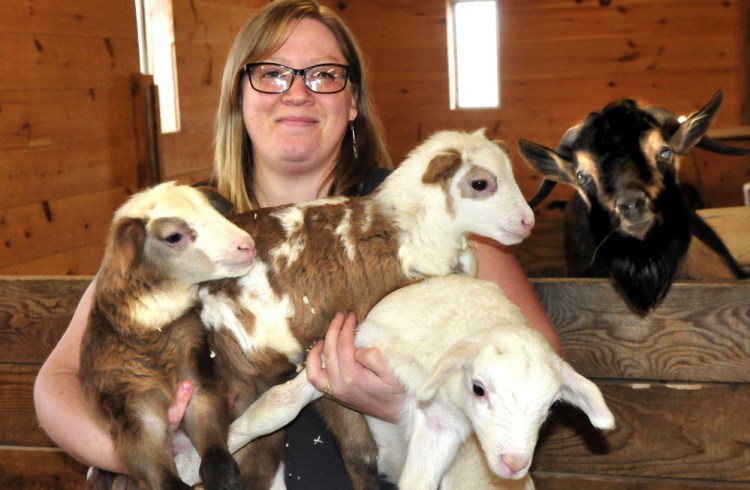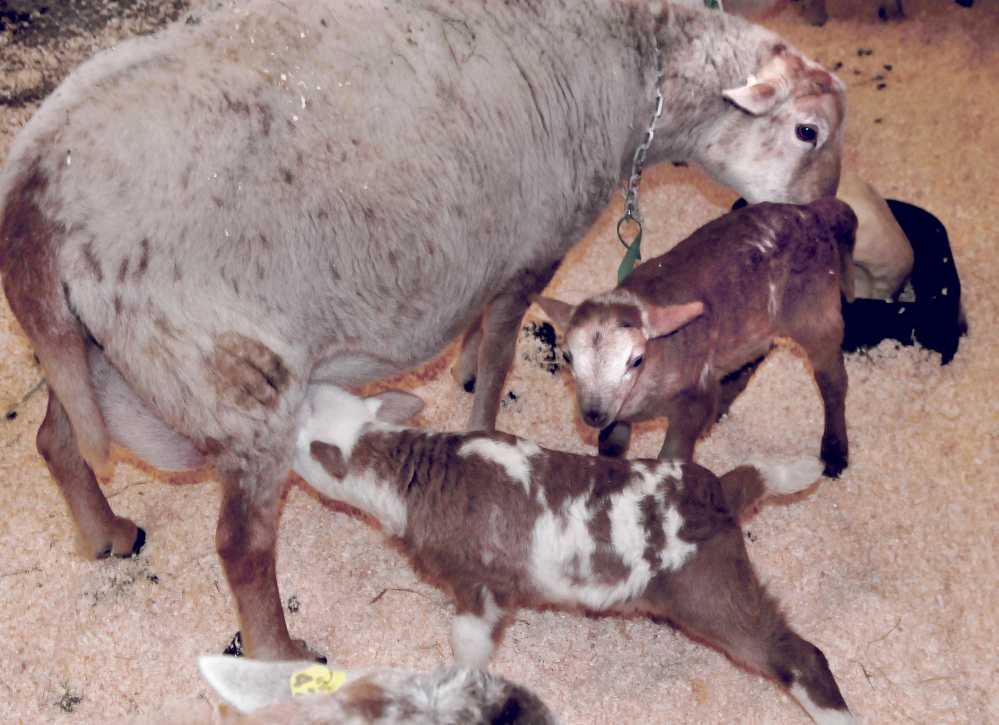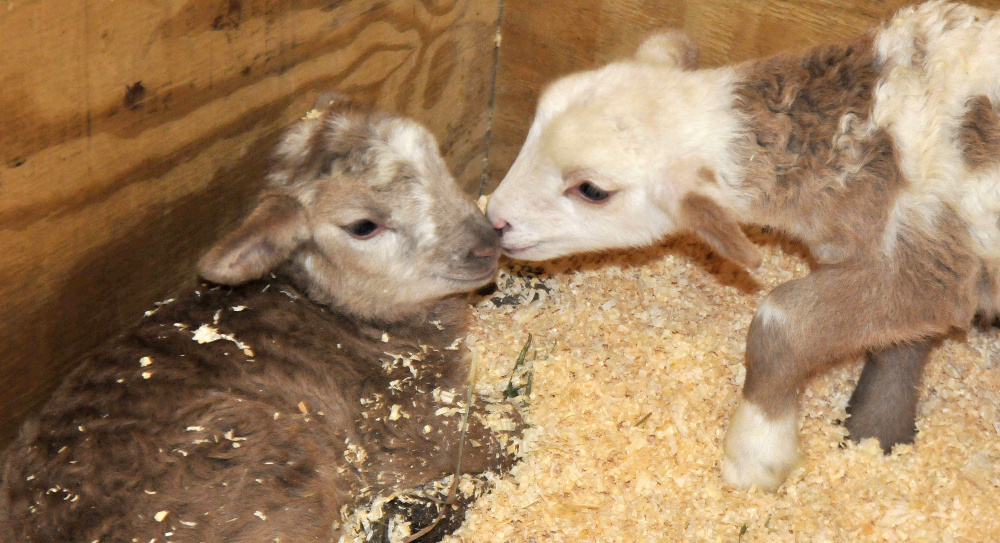UNITY — When Meg Anderson walked in the door of the barn she manages at Unity College Monday morning, she found something new: Moxie, one of the pregnant sheep, already had given birth to a lamb.
A few minutes later, another came out. Then, another.
It was the first set of triplets for the college’s Heritage Livestock Barn, which is used to teach students in the captive wildlife care and sustainable agriculture majors and currently has a record number of lambs — 11 — at the moment.
“Twins are most common, so it was a real surprise for us to get triplets,” Anderson said, adding that although not rare, triplets account for a much smaller percentage of births in Katahdins.
The lambs, all born between 7 a.m. and 7:30 a.m., were named after national parks and monuments: Mammoth, Mojave and McKinley.
Sheep are pregnant for five months before giving birth, and lambs are ready to go almost as soon as they’re born.
“Almost immediately, five to 10 minutes after birth, they’re up and nursing,” Anderson said. “After a few days, they’re up and running and jumping around.”
McKinley was “rejected” by her mother soon after birth, which means she wasn’t allowed to nurse like her brother and sister were. Anderson says this can happen when the mother doesn’t spend enough time cleaning off and bonding with her baby after birth. McKinley was also the smallest of the three, which put her at an additional disadvantage.
Anderson said she found a woman who is fostering McKinley and bottle-raising her. Eventually, it will join the woman’s own flock of sheep.
Usually, Anderson said, they have about four to six lambs at a time. Right now, that number is 11, a record.
The student population is increasing, she said, so she has to make sure there are enough animals to handle the classes and laboratory time spent at the barn.
For example, if there are two laboratories with 15 students each in one day, that’s 30 students who are examining the animals, she said. The more animals in the barn, the less stress each one has to go through.
Students who major in captive wildlife care and education will all have classes and laboratories that use the barn, Anderson said. As of the spring 2017 semester, the major has the second-highest enrollment after conservation law enforcement, with 123 students, and is designed to prepare students to work in zoos or wildlife rehabilitation, among other things.
“For one of their first classes, we wrangle the sheep and we trim their hooves,” she said. The animal management experience they learn through the farm gets them comfortable with handling animals that are larger than the average household pet, which they may need to do for their careers, she said.
Students also learn how to train the sheep, which can learn to respond to clickers or run around cones, Anderson said.
“Sheep are smarter than most people give them credit for,” she said.
In addition to the hands-on classes, arts classes sometimes will use the rural resources the college provides for inspiration.
“They literally sit out on a grassy knoll and look out on the pasture while painting and drawing what they see,” Anderson said. Parks and forestry majors also will give tours through the farm for practice.
“We are trying to make (the farm) as available as possible,” she said.
Anderson was a student at Unity College herself, graduating in 2009. She was on a track to become a field ecologist but later decided her passion was in farming.
She first worked at Johnny’s Selected Seeds before becoming the first barn manager in 2013. Anderson also runs her own farm at home, raising heritage pigs and selling piglets to people who want to raise their own meat for their families, she said. She holds up a lamb, named Shiloh, saying he’ll be joining the small group of Katahdin sheep she also raises.
The barn at Unity College was built by students in 2008 in an environmental citizenry class.
After they outfitted the framework with insulation and the necessary parts, such as feeders, the college brought in the first animals in the late summer of 2013.
All of the animals are American heritage breeds, which are considered traditional livestock breeds that came before an increase in industrialization in agriculture wiped out variety. The barn’s goats were bred in California, the pigs in Georgia, the rabbits in Ohio and the chickens in New York.
The sheep are bred in Maine. They’re known as the Katahdin breed and are the only unique sheep created in the state. They’re also one of the fastest growing breeds in the world in terms of popularity, Anderson said, because they’re easy to manage.
Katahdin sheep don’t have horns, which can cause injuries, and they don’t require a cropped tail because they are hair sheep, meaning they don’t grow wool but rather grow a double coat in winter and then shed it all in clumps in the summer. Anderson said she’s been tricked by large piles of the hair she’s seen from far away in the fields before, thinking she’s found a newborn lamb.
While they can’t be used for wool, the sheep are used for lamb meat, milk or training.
Some people will keep a small flock of Katahdin sheep for training new sheepdogs, Anderson said.
“I think a lot of that is because of the Katahdin’s mild temperament,” she said, adding that the breed is “less flighty” than others.
The college doesn’t keep all of the sheep that it breeds. It will sell all 11 lambs, Anderson said, and about 90 percent probably will go on to be future breeders because of their pedigree. Others might be used for milk, and some that are considered lower quality because of genetic abnormalities will be used for meat.
Madeline St. Amour — 861-9239
mstamour@centralmaine.com
Twitter: @madelinestamour
Send questions/comments to the editors.






Success. Please wait for the page to reload. If the page does not reload within 5 seconds, please refresh the page.
Enter your email and password to access comments.
Hi, to comment on stories you must . This profile is in addition to your subscription and website login.
Already have a commenting profile? .
Invalid username/password.
Please check your email to confirm and complete your registration.
Only subscribers are eligible to post comments. Please subscribe or login first for digital access. Here’s why.
Use the form below to reset your password. When you've submitted your account email, we will send an email with a reset code.